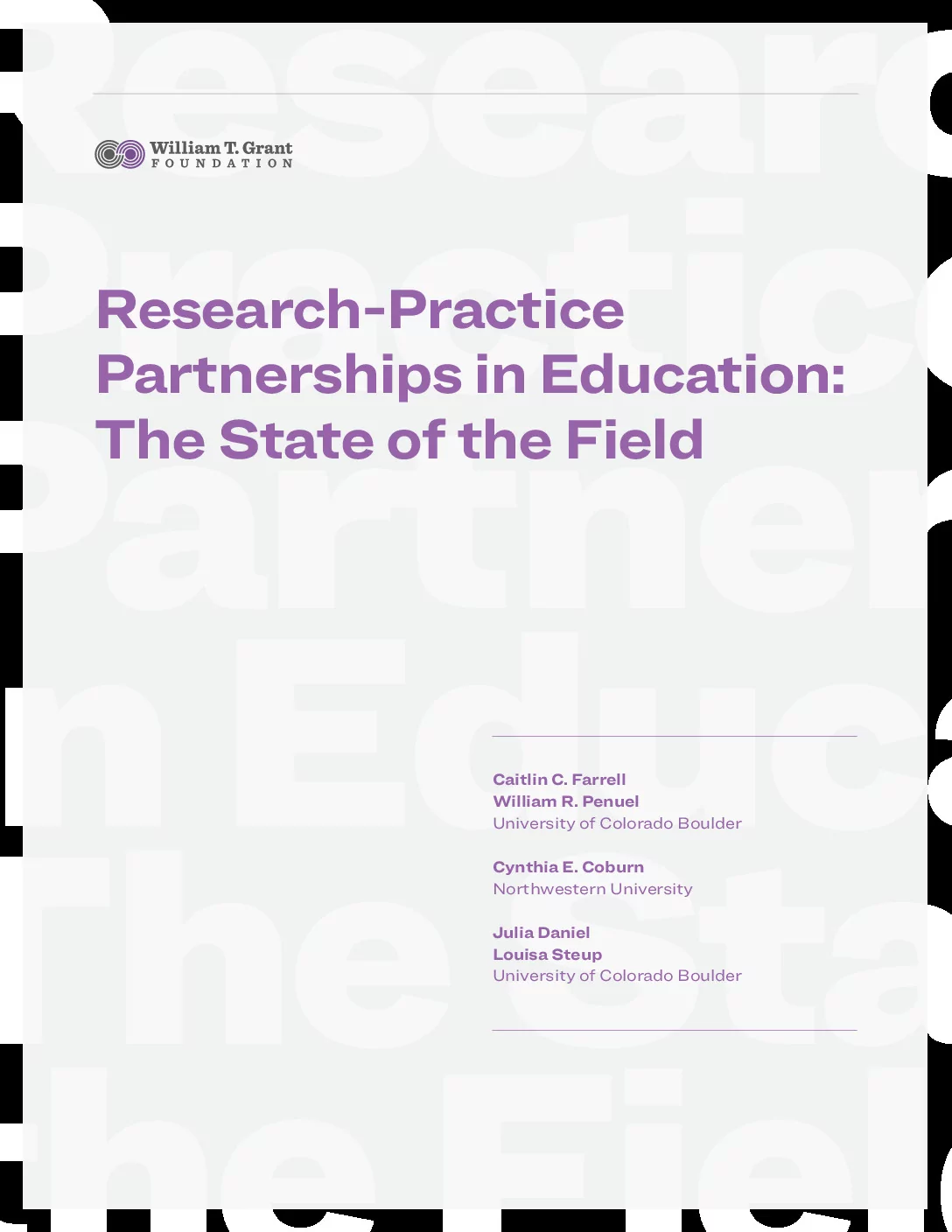Change is elemental to research-practice partnerships. Designed to diverge from traditional approaches to research by shifting power relations and engaging perspectives from outside the academy, it is no surprise that RPPs continue to pursue new avenues for producing knowledge and improving systems. But in a field that embraces both hybridity and diversity, what do we know about how RPPs define objectives, support communities, and contribute to positive change?
Drawn from interviews with dozens of RPP leaders and a literature review spanning hundreds of recent empirical studies, Research-Practice Partnerships in Education: The State of the Field offers a snapshot of the RPP landscape at a pivotal moment. Prospective partners can use the ideas to inform how, why, and with whom they may organize an RPP, while existing RPPs may draw on the ideas when planning and implementing next steps. For funders and policymakers, these ideas can help clarify what RPPs are—and what they are not—and offer first-hand insights on their potential.
Executive Summary
Research-practice partnerships (RPPs) are an important part of the educational ecosystem that connects research, policy, practice, and community work in the United States. They are a prime example of how long-term collaborative approaches to research can address persistent challenges and systemic inequities in our schools and communities.
Research-Practice Partnerships in Education: The State of the Field expands on the 2013 white paper Research-Practice Partnerships: A Strategy for Leveraging Research for Educational Improvement in School Districts by scanning the current landscape of partnerships, identifying points of variation, and outlining shared principles.
Redefining RPPs
First, the report offers a new way of defining a research-practice partnership in education:
A long-term collaboration aimed at educational improvement or equitable transformation through engagement with research. These partnerships are intentionally organized to connect diverse forms of expertise and shift power relations in the research endeavor to ensure that all partners have a say in the joint work.
From this definition, five principles emerge that highlight the differences between RPPs and other kinds of partnership in education or other forms of research:
- They are long-term collaborations.
- They work toward educational improvement or equitable transformation.
- They feature engagement with research as a leading activity.
- They are intentionally organized to bring together a diversity of expertise.
- They employ strategies to shift power relations in research endeavors to ensure that all participants have a say.
Dimensions of Variation
Second, the authors move away from categorizing distinct types of RPPs—such as research alliances, design partnerships, and networked improvement communities—and instead delineate a set of four dimensions along which RPPs vary, namely: goals pursued, composition, research approaches, and funding sources. Characterizing the field in this way provides a frame for current and would-be RPP participants to consider the affordances and constraints of each unique approach to partnership work.
- With respect to an RPP’s goals, two elements are critical: whether the scope of work is focused or broad, and whether members of the RPP conceive of equity as central to the process of partnering, or as central to the outcomes the partnerships seek to achieve.
- The composition of RPPs also varies with respect to the partners and organizations involved. Researchers in universities and research nonprofits may partner with state agencies, local school districts, schools, community organizations, families, youth, or other stakeholders. RPPs might also comprise two or more organizations and/or actors from multiple tiers of an educational system.
- RPPs’ approaches to research constitute another dimension along which they may vary. While all RPPs engage with research as a leading activity, how RPPs structure their research varies by inquiry activity, length and intensity of an engagement, and roles for participants.
- Finally, RPPs rely on different funding sources. National public and private funders have supported research in partnership, as have local and regional foundations. Available funding impacts whether and how RPP work can proceed, and the nature of the work RPPs can undertake given various funding priorities, focus areas, structures and limitations on what funding can support, and the funder’s level of involvement.
Moving Forward
Third, the report conveys four pressing issues identified by RPP leaders as essential for the field to address in its continued commitment to RPPs:
- Understanding how well RPPs meet their goals and the conditions that support or hinder their progress.
- Cultivating the next generation of RPP leaders to develop the range of skills, knowledge, dispositions, and orientations needed to engage in partnership efforts.
- Building operational capacity for RPPs through dedicated funding.
- Learning at the boundaries with other forms of collaborative research such as collaborative community-engaged research, community research collaboratives, participatory action research, youth participatory action research, participatory design research, and other forms of collaborative work to transform institutions to work toward more just futures.
RPPs—the work they do, the communities they engage, and the goals they pursue—will continue to evolve. This paper offers a snapshot of the landscape of RPPs at a pivotal moment. Prospective partners can use the ideas shared to inform how, why, and with whom they may organize an RPP, while existing RPPs may draw on the ideas when planning and implementing next steps. For funders and policymakers, these ideas can help clarify what RPPs are—and what they are not—and offer first-hand insights on their potential.




